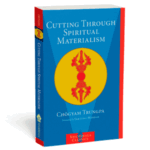Reviewed by Charles Prebish
In the spring of 2002, following a short bout with cardiac problems, I decided to move most of my books from my university office to my home study to allow me to work in a more relaxing environment. By some odd chance-probably karmically inspired-the very first books I grabbed down off the shelf were old, yellow, held-together-by-Scotch-tape copies of Chogyam Trungpa's Meditation in Action and Cutting Through Spiritual Materialism. These were the first books of Trungpa Rinpoche's I had read, and to me, they remain his very best.
As I leafed through my tattered old copies, I was propelled back in time to the fall of 1973, when I was planning to teach a course called 'East Meets West: Chogyam Trungpa and Carlos Castaneda.' While students were walking around Penn State's campus with TheTeachings of Don Juan or Tales of Power stuffed in the back pocket of their jeans-much the way I walked around ten years earlier with Kerouac's The Dharma Bums stuffed in mine-I was reading Meditation in Action and Cutting Through Spiritual Materialism again and again, finding something new and startling with each reading.
In my youthful naivete, I even wrote to Trungpa Rinpoche, whom I had never met, and asked him if he would consider coming to Penn State to lecture to the course about his experiences in Tibet and in bringing the buddhadharma to America. I was shocked when I got back a handwritten note from him, saying simply: ÒYes, if you think itÕs important.Ó Overjoyed, I immediately went about the business of securing funding to pay for his expenses and an honorarium, and when everything was in place, wrote him back inquiring as to his travel requirements. In typical fashion, he never answered. Nevertheless, the course was held the following spring as planned, with Meditation in Action and Cutting Through Spiritual Materialism as texts. And of course I was shocked when I eventually did hear from Trungpa Rinpoche, although it was only to invite me to teach Sanskrit at the first summer of Naropa Institute, and without even a mention of my then in-progress course.
I bet I've read Meditation in Action fifty times over the years. One wouldnÕt think you could pack so much interesting material into a tiny little book thatÕs just over one hundred pages, but Trungpa Rinpoche didÑfor me at least. Each time I flip back through those turned-down pages, I find something new. This last time I was struck by the simple purity and power of the chapter on transmission. He says, 'Transmission does not mean that the Teacher is imparting his knowledge or his discovery to youÑthat would be impossible, even Buddha could not do so. But the whole point is that we stop collecting more things, and we just empty out whatever we have.Ó A little later he went on to say, ÒAnd when he has opened himself the Teacher will say a few words, which probably do not mean very much. Or perhaps he will not say anything. The important thing is to create the right situation, both on the TeacherÕs part and on the pupilÕs part. And when the right situation is created, then suddenly the Teacher and the pupil are not there anymore. The Teacher acts as one entrance and the pupil acts as another, and when both doors are open there is a complete Emptiness, a complete Oneness between the two.Ó
One wonderful morning in 1970, at the conclusion of my weekly debate with my academic mentor Richard H. Robinson, I had exactly the experience Trungpa Rinpoche described. Only this time, for some reason, Robinson had required that my wife and newborn son be present for our intellectual battle. Any grasping at permanence was quickly dispelled, as later that afternoon Robinson was caught in a house explosion and fire. The injuries he sustained ended his life a month later. In 1974, when I told Trungpa Rinpoche about that experience, he simply smiled and hugged me.
The same continual lessons emerge from the chapter on self-deception in Cutting Through Spiritual Materialism. When Trungpa Rinpoche points out that ÒSelf-deception needs the idea of evaluation and a very long memory,Ó he couldnÕt be smarter. I am always reminding myself of the immense truth of one small sentence in that chapter: ÒIf we regard something as valuable and extraordinary, it becomes quite separate from us.Ó He goes on to explain how we grasp after that inspiration precisely because we donÕt want to lose it. Over the years, IÕve learned again and again just how accurate and pervasive those two magical little books are, as goals, friendships and even desires slip away with each new act of fear and grasping.
In recent years I've found a more portable little book to carry around with me, and I take it everywhere. It fits right in my jacket pocket, near my heart. It's John Daido Loori's Invoking Reality: Moral and Ethical Teachings of Zen. In it, Daido Roshi reviews taking refuge in the three treasures, the three pure precepts, and the ten grave precepts. His prose has the same simplicity and power that Trungpa RinpocheÕs volumes have, and they tear away my pretenses just as quickly. I suppose itÕs no wonder I met Daido Roshi at that first summer of Naropa Institute. Perhaps Trungpa Rinpoche wanted to make sure I had new dharma books to read and teachers to learn from long after he was writing no more.
From Buddhadharma: The Practitioner's Quarterly (www.thebuddhadharma.com). Charles Prebish is Professor of Religious Studies at Pennsylvania State University and coeditor of Buddhism in the Modern World: Adaptations of an Ancient Tradition (Oxford University Press, 2003).

